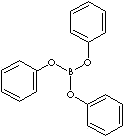|
TRIPHENYL BORATE |
| Boric acid triphenyl ester; Trifenylester kyseliny borite; Phenyl borate; Tris(phenoxy)borane; Triphenoxyborane; Triphenoxyboron; |
|
|
| PRODUCT IDENTIFICATION |
|
|
CAS RN |
1095-03-0 |
|
EINECS RN |
214-137-0 |
|
FORMULA |
(C6H5O)3B |
|
MOLE WEIGHT |
290.12 |
|
|
| PHYSICAL AND CHEMICAL PROPERTIES |
|
|
PHYSICAL STATE |
white to off-white crystalline powder |
|
MELTING POINT |
98 - 101 C |
|
BOILING POINT |
|
|
DENSITY |
|
|
SOLUBILITY IN WATER |
|
|
pH |
|
|
VAPOR DENSITY |
|
|
REFRACTIVE INDEX |
|
|
FLASH POINT |
|
|
|
| STABILITY AND REACTIVITY | |
| STABILITY | Stable under normal conditions |
|
INCOMPATIBLE MATERIALS |
Strong oxidizing agents. Moisture. |
| DECOMPOSITION PRODUCTS |
Carbon oxides, Boron oxides, Phenol. |
| POLYMERIZATION | Has not been reported |
|
NFPA RATINGS |
|
|
|
| SAFETY |
|
|
HAZARD NOTES |
Highly Flammable. Toxic by inhalation, in contact with skin and if swallowed. Risk of serious damage to eyes. |
|
EYE |
|
|
SKIN |
|
|
INGESTION |
|
|
INHALATION |
|
|
CHRONIC |
|
|
|
| TRANSPORT & REGULATORY INFORMATION |
|
|
UN NO. |
2811 |
| HAZARD CLASS |
6.1 |
| PACKING GROUP |
III |
| HAZARD SYMBOL |
F,T |
|
RISK PHRASES |
11-23/24/25-41 |
|
SAFETY PHRASES |
16-26-36/37/39-45 |
|
|
| OTHER INFORMATION |
|
1.http://www.chem.wisc.edu/areas/reich/chem842/_chem842-07-boron.htm (Boron Chemistry) 2.The general formula for boric acid esters is B(OR)3. The lower molecular weight esters such as methyl, ethyl, and phenyl are most commonly referred to as methyl borate, ethyl borate, and phenyl borate, respectively. Some of the more common boric acid esters used in industrial applications are trimethyl borate, trimethyl borate azeotrope, triethyl borate, triethyl borate azeotrope, tri-n-propyl borate, triisopropyl borate, tri- n-butyl borate, triphenyl borate, tricresyl borate, trimethoxyboroxine, and triisopropoxyboroxine. Most reported boric acid esters are trialkoxy or triaryloxy boranes. The esters range from colorless low boiling liquids to solids that possess high melting points. Boric acid esters usually have an odor similar to the hydroxy compound from which they are derived. Alkyl boric acid esters derived from straight-chain alcohols and aryl boric acid esters are stable to relatively high temperatures. Trialkoxyboranes from branched-chain alcohols are much less stable, and boranes from tertiary alcohols can even decompose at 100°C. Decomposition of branched-chain esters leads to mixtures of olefins, alcohols, and other derivatives. Methods used for the preparation of borate esters, include the esterification of boric acid or boric oxide, B2O3, and transesterification. Most methyl borate is produced by Morton International and used captively to manufacture sodium borohydride. Aryl borates produce phenols when in contact with water and are therefore subject to shipping regulations governing such materials and must carry a Corrosive Chemical label. Lower alkyl borates are flammable; methyl, ethyl, and butyl borates must be stored in approved areas. Other compounds are not hazardous. Boric acid esters are used in the production of sodium borohydride, gas fluxing, as polymer additives, in hydraulic fluids and lubricants, as biocides, and in hydrocarbon oxidation. (source: http://mrw.interscience.wiley.com/emrw/9780471238966/kirk/article/boridock.a01/current/abstract) 3.Triphenyl borate is a Lewis acid which act as reaction rate accelerators or inhibitors in polycarbonate polymerization by enhancing the electrophilicity of the carbonyl group. |
|
|
| SALES SPECIFICATION |
|
|
APPEARANCE |
white to off-white crystalline powder |
| ASSAY |
98.0% min |
|
MELTING POINT |
98 - 101 C |
